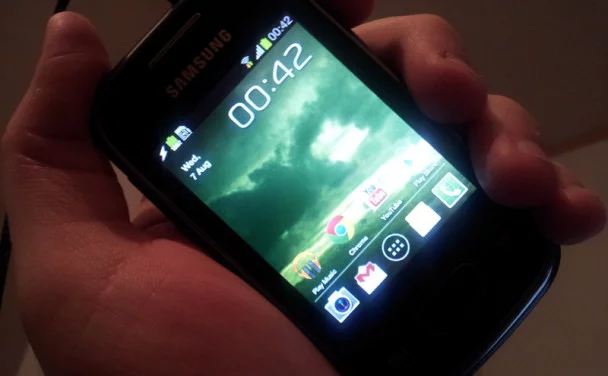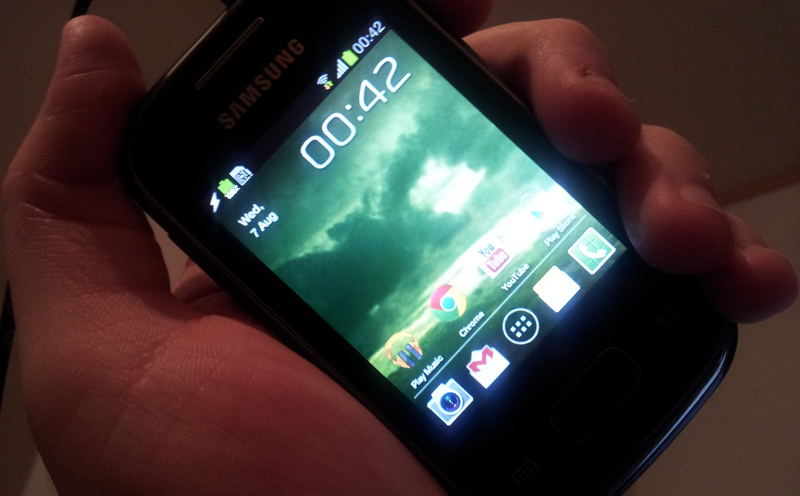What can you do with a spare entry-level Android phone? Part 1: First impressions

Occasionally, local electronics stores here in Norway offer up entry level Android phones for ridiculously low prices. I’ve let those chance slip in the past, but when I got another chance to grab one today, I did. For 295 NOK- which is the price of about three Big Mac combo meals here in Norway- I ended up with an unlocked Samsung Galaxy Pocket plus S5301.
The S5301 is as entry level as it gets. It has a 240×320 pixel screen, an 850MHz CPU, 512MB of RAM, a 2 megapixel rear camera, 4GB of internal memory, an SD card slot, GPS, Android 4.0, and a few other standard specs like Bluetooth. The resolution of the 2.8-inch screen is definitely the most noticeably cheap part of it, as the rest of the specs are at least semi-decent. For the price, however, it’s hard to call it anything but a steal.
The reason why I bought one is simple: I want to play with it. I want to have a spare Android phone that I can do whatever I want to without risking an expensive device, and just having a second Android phone around in itself opens up for some interesting experimentation. I also wanted to see how viable the device is for someone who doesn’t have an smartphone at all, and I’m just outright curious what I could get for this little money.
I had barely even gotten it turned on before I went looking for a root method, and found one. With root available, I put Titanium Backup to work freezing most of the software that was on the phone, as Samsung’s bloatware tendencies certainly aren’t diminished on budget devices. I replaced the launcher, browser, and simply cleaned up the phone. There’s no custom ROM for this thing (yet), so this is basically the closest I can get to stock Android. Even so though, Touchwiz is very present, and that annoys me.
With all of that in order, I started seeing what the phone can actually do. I have to say that if this thing had a better screen, it would have just made it so much better, though the low resolution might also explain why the device runs fairly well on such low specs. It does hang for a couple of seconds every once in a while, but other than that, it’s managing quite well.
As for what I want to do with it, I have a ton of ideas. I’m currently testing how stable AutoVoice Continuous is on the thing, and so far it’s doing great. For those who don’t know, AutoVoice Continuous is the constantly listening mode for the AutoVoice Tasker plug-in, allowing you to custom create a voice assistant that is listening to you 24/7. You know, like what the Motorola Moto X has…just that AutoVoice was first…and runs on a device whose price you can count in cheeseburgers.
In all fairness, the Moto X’s real benefit is that it has a dedicated core for this feature, while other devices need to use a lot of power to keep it going. As such, I have an idea to make the S5301 a permanent part of my apartment, and create a magnetic charging system for it. The idea I have is to create a stand with magnets that snap onto magnets on the phone, and charges through that connection. It’s an idea I’ve played with before, but the dealbreaker has always been that it would be a major and noticeable modification to a portable device. With a small, cheap phone that doesn’t need to go anywhere, it doesn’t matter if I add some bulk to it.
If I get that or something similar set up, the hope is that AutoVoice Continuous will be able to run all the time on the S5301, eliminating the battery issue by always powering it. In theory, that will allow me to move a lot of voice commands for my home automation system off my primary phone (where I need to trigger voice control before I speak), and have a permanent, completely hands-free option instead. First, however, I need to find out how stable AV-C is on this thing.
I might also look into doing something in the realm of device-device communication with this phone. Thanks to AutoRemote I can make the S5301 talk to my primary phone, and set up the two to cooperate. I’m not sure exactly what to use that for yet, but the point is that if I can imagine it, I can very likely make it.
The potential here is huge, and with this device I never have to worry about breaking it or wasting an expensive device on minor tasks. I will report back once I’ve decided what I want to- and can- do with this thing.


